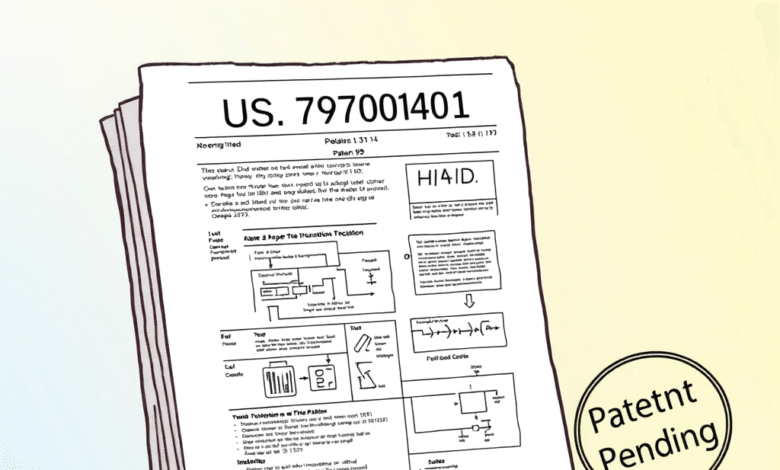Exploring US7970040B1: The Patent Behind Interactive Real-Time Streaming Technology

In the ever-evolving landscape of digital media, real-time content streaming has become an integral part of how people consume information, communicate, and interact. From webinars and virtual conferences to livestream shopping and online education, the seamless integration of real-time video with user interaction is more than just a convenience—it’s a technological breakthrough. One of the foundational patents behind this revolution is US7970040B1, a significant intellectual property asset granted to Google Inc. that enables the creation and distribution of real-time interactive media through internet protocol (IP) networks.
This article explores the core of this patent, its technological implications, real-world use cases, and how it continues to shape the digital world today.
What Is US7970040B1?
US7970040B1 is a United States patent titled “System and method for creating and distributing real-time interactive media content through internet protocol (IP) networks.” Filed in 2007 and granted in 2011, the patent describes a technological framework for delivering real-time video content combined with interactive features—such as polls, quizzes, or user feedback—through IP networks like the internet.
At its core, the invention enables:
- Broadcasting live media content
- Overlaying interactive elements (e.g., clickable buttons, forms, graphics)
- Personalizing the viewer experience
- Real-time two-way communication between the broadcaster and the audience
The system uses multiple distributed components to capture, process, stream, and interact with the data in real-time. These components may include a content creation station, distribution servers, and viewer-side rendering systems that integrate interactive media on the fly.
The Technological Backbone
Let’s break down the core technologies defined in US7970040B1:
- Modular Media Capture
The system begins with a media capture system—such as a webcam or video encoder—that collects audio and video data in real-time. - Media Encoding and Packaging
This raw content is encoded using suitable codecs (e.g., H.264) and packaged in a format that can be easily transmitted over IP networks. The encoding also includes metadata, such as interactive triggers. - Content Distribution Network (CDN) Integration
To ensure low-latency, scalable delivery, the system leverages a CDN infrastructure, sending the data to geographically distributed servers closer to end-users. - Interactive Element Layering
One of the key differentiators is the integration of interactive elements. These are defined by XML or other markup languages and allow for live engagement through clickable links, surveys, or live chat. - Real-Time Feedback and Analytics
The system also supports return data channels, allowing users to respond in real time. This feedback can be analyzed instantly or stored for post-broadcast evaluation.
Why Was This Patent Revolutionary?
When the patent was filed, online video was in its infancy. YouTube had just been acquired by Google, and most online media was pre-recorded and passive. Live television required expensive infrastructure and lacked the ability to include real-time feedback or personalized interactions.
US7970040B1 enabled something that had been technically difficult and cost-prohibitive: a scalable, internet-based platform where live content could not only be streamed but also interacted with dynamically.
It democratized the production of live, engaging content—paving the way for tools like:
- YouTube Live
- Google Meet and Hangouts
- Live e-learning platforms (e.g., Coursera, Udemy live sessions)
- Livestream e-commerce (popular in China and now globally)
- Interactive news broadcasts and political town halls
Real-World Applications of US7970040B1
1. YouTube Live
As a Google product, YouTube Live is perhaps the most obvious beneficiary of this patent. Streamers can broadcast video in real time, while the audience engages through live chat, reactions, polls, and clickable links—all features covered by this patent.
2. Webinars and Virtual Classrooms
Tools like Zoom, Google Meet, and Microsoft Teams incorporate the core ideas from US7970040B1. These include real-time video, screen sharing, integrated Q&A, and chat—all underpinned by the delivery and interaction mechanisms described in the patent.
3. E-Commerce and Livestream Shopping
In countries like China, livestream shopping is a billion-dollar industry. Viewers interact with hosts in real time, ask questions, click to buy, and even vote on product features—all real-time functionalities addressed by this patent.
4. Remote Work and Virtual Events
During the COVID-19 pandemic, this patent became more relevant than ever. Virtual conferences, live online workshops, and remote collaboration platforms all rely on this form of interactive streaming to maintain engagement and productivity.
Patent Citations and Legal Influence
US7970040B1 has been cited by numerous other patents in the domain of media streaming, real-time analytics, and interactive video applications. This suggests its broad influence on the development of web-based communication tools.
It also holds strategic value in intellectual property disputes around video delivery and user interaction technologies. As companies compete in livestreaming, education tech, and conferencing tools, having foundational patents like this one is crucial for defending market positions.
Challenges and Limitations
Despite its groundbreaking vision, the patent was developed during a time of relatively limited broadband infrastructure. As such, its early implementation may have faced issues like:
- Latency and buffering
- Bandwidth constraints
- Device compatibility
Fortunately, modern advances—like fiber-optic internet, 5G, and more efficient codecs—have made these technologies more accessible and seamless.
The Future of Interactive Streaming
As we look ahead, the principles defined in US7970040B1 will continue to evolve. Emerging trends include:
- AI-driven personalization
Adaptive content that changes based on real-time viewer behavior or preferences. - Augmented and Virtual Reality
Integrating real-time interactive video into 3D environments for immersive experiences. - Blockchain and Decentralized Media
Using distributed systems for content rights, monetization, and distribution. - Edge Computing
Reducing latency by moving processing closer to the viewer, enhancing the interactive capabilities first envisioned by this patent.
Conclusion
U.S. Patent US7970040B1 is more than a technical document—it’s a blueprint for modern online communication. From livestreaming your favorite content creator to participating in a virtual classroom, the concepts and systems defined in this patent power much of today’s internet experience.
As the digital world becomes more interactive, immersive, and real-time, the importance of this foundational technology will only grow. It marks a turning point in how we think about video—not just as something to watch, but as something to engage with, in real time, from anywhere in the world.






